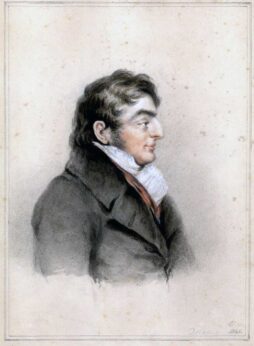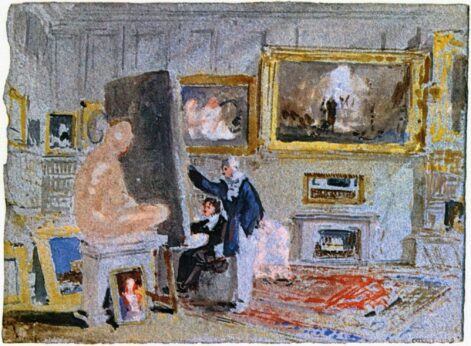

In 19th-century England, a new realism in painting emerged, driven by the country’s more advanced capitalist development compared to the European continent. Benjamin Robert Haydon (1786–1846) created the first urban street scenes, while Scottish artist David Wilkie (1785–1841) elevated genre painting of bourgeois daily life, often infusing it with social critique. However, landscape painting—rooted in the realistic tradition of 17th-century Dutch art—became the hallmark of bourgeois realism. Artists such as John Crome (1768–1821), John Constable (1776–1837), and especially J.M.W. Turner, known as William Turner (1775–1851), played a key role in this development.
Turner’s work increasingly sought to capture the immense forces of nature, often reflecting social transformations and issues. His art provides a compelling window into his rapidly modernizing era. A lifelong fascination with inventions, politics, society, culture, and science shaped many of his most original works and deeply influenced his technique. Beyond landscapes, he was captivated by machines and industry, making him the first painter to recognize and integrate the Industrial Revolution into landscape painting.
To honor William Turner on his 250th birthday—he was born in Maiden Lane, Covent Garden, London, on April 23, 1775—we take a closer look at Turner’s renowned painting Rain, Steam, and Speed—The Great Western Railway (1844), where steam power, a defining force of England’s Industrial Revolution, takes center stage.
As Engels wrote in 1845 in the introduction to The Condition of the Working Class in England: “The history of the proletariat in England begins with the second half of the last century, with the invention of the steam-engine and of machinery for working cotton. These inventions gave rise, as is well known, to an industrial revolution, a revolution which altered the whole civil society; one, the historical importance of which is only now beginning to be recognized. England is the classic soil of this transformation, which was all the mightier, the more silently it proceeded; and England is, therefore, the classic land of its chief product also, the proletariat.”
The railway profoundly transformed perceptions of distance, speed, and time. With its expanding network, it brought places closer together, enabling unprecedented mobility. The introduction of Greenwich Mean Time replaced regional time zones, standardizing schedules across the country. These radical changes were captured by J. M. W. Turner in this groundbreaking oil painting.
The Great Western Railway, designed by the brilliant engineer Isambard Kingdom Brunel, connected London with the port of Bristol. At the heart of Turner’s painting is the Firefly locomotive, a new class of train introduced in 1841, capable of reaching speeds of 80–100 km/h (50–60 mph). The train, racing through torrential rain, dominates the scene as it crosses the Maidenhead Bridge—another of Brunel’s engineering marvels. At the time, this bridge boasted the widest and flattest arches ever built, supporting the fastest railway in existence.
Turner was the first artist to capture the breakneck speed of a train on canvas. The locomotive rushes toward the viewer like a fiery abyss, its force amplified by the dramatic diagonal composition. The stark contrast between the train’s massive black iron body and the swirling, rain-laden atmosphere heightens the sense of motion. Fleeting sunlight pierces through storm clouds, while the blurred landscape vanishes into a haze of speed and rain. The smokestack, the only sharply focused element, glows with reflected light. The exposed boiler, burning brightly like an open ironworks, intensifies the image’s raw energy. Behind this mechanical beast, third-class passengers huddle in open-air carriages, their bonnets, top hats, and hoods offering scant protection against the elements.
The painting’s title subtly references an 1841 railway disaster, when a train derailed due to a landslide caused by heavy rain, killing eight and injuring 17 third-class passengers. The hare in the foreground—a creature often associated with misfortune—may carry symbolic meaning, reinforcing the dangers of modern technology.
Turner masterfully conveys the railway’s impact on the landscape. An old stone bridge from 1770, now empty, stands in contrast to the bustling railway bridge, highlighting the shift from past to present. The speed of the train is underscored by its diagonal trajectory, trailing steam, and the barely discernible hare—England’s fastest land animal—vainly attempting to outrun it. To the right, a horse-drawn plough moves in the opposite direction, a stark reminder of traditional labor. On the left, figures dancing near the river appear ghostlike, obscured by steam. A small rowing boat drifts slowly below, further emphasizing the relentless forward motion of the locomotive.
Every element in the composition intensifies the sensation of unstoppable progress. The train cuts through the canvas, bisecting time itself—past and future, old and new. Turner’s swirling, dynamic brushstrokes mirror the turbulence of industrial change, capturing with unparalleled intensity the relentless pace of modernity.
In contrast to the steamship on the sea, the railway, on iron rails, cuts through a landscape altered by humans: new transport routes, viaducts, and cleared land. The railway, as a symbol of progress and the pace of time, becomes in this painting an impressive expression of modernity with its challenges. To depict this train in full motion required new artistic solutions. The hot metal of the wheels and rails turns the dense rain into steam, and the imposing height of the bridge suddenly appears threatening. At the same time, the image of concentrated heavy industry rapidly moves toward the fields in the foreground, which are hidden in the fog. The train driver, stoker, and passengers in this train are all workers.
William Makepeace Thackeray commented on the formal boldness of the painting, addressing Turner’s innovative painting techniques:
“He has made a picture with real rain, behind which is real sunshine, and you expect a rainbow every minute. Meanwhile, there comes a train down upon you, really moving at the rate of fifty miles an hour, and which the reader had best make haste to see, lest it should dash out of the picture, and be away up Charing Cross through the wall opposite. All these wonders are performed with means not less wonderful than the effects are. The rain, in the astounding picture called “Rain-Steam-Speed,” is composed of dabs of dirty putty slapped on to the canvas with a trowel; the sunshine scintillates out of very thick, smeary lumps of chrome yellow. The shadows are produced by cool tones of crimson lake and quiet glazings of vermilion. Although the fire in the steam-engine looks as if it were red, I am not prepared to say that it is not painted with cobalt and pea-green. And as for the manner in which the “Speed” is done, of that the less said the better—only it is a positive fact that there is a steam-coach going fifty miles an hour. The world has never seen anything like this picture.”

Turner’s painting style is defined by its unacademic approach. He used a variety of techniques, including brushes, spatulas, and even his hands, to blend colors. This experimental method played a crucial role in creating the signature atmospheric effects of his work. Notably, his dissolution of contours, subtle gradations of color and light, and striking contrasts of brightness and shadow, dominated by luminous, glowing hues, became hallmarks of his artistry.
Although Turner sketched and studied scenes on-site, he painted the final works in his studio. Yet he masterfully captured his vivid sensory impressions and emotional experience, ensuring his paintings remained deeply connected to his perception of life.
In 1848, Marx and Engels described in the Communist Manifesto the unstoppable revolutionizing of the productive forces by the bourgeoisie and the accompanying transformation of social relations: “The bourgeoisie, during its rule of scarce one hundred years, has created more massive and more colossal productive forces than have all preceding generations together. Subjection of Nature’s forces to man, machinery, application of chemistry to industry and agriculture, steam-navigation, railways, electric telegraphs, clearing of whole continents for cultivation, canalization of rivers, whole populations conjured out of the ground—what earlier century had even a presentiment that such productive forces slumbered in the lap of social labor?”
Turner gives dynamic expression to this power in his depiction of the railway. He developed an artistic language that broke away from traditional sharp contours, clear separations of individual motifs, and rigid compositional structures. His distinctive style allowed him to capture phenomena never before seen on canvas. Rather than presenting nature as static, he revealed how perception shapes experience. Turner’s vision of a world where the strict division between objects and phenomena no longer applies reflects an innovative perspective that transcends traditional boundaries, placing the interaction between subject and environment at its core. Few works from his time compare to his, and none parallel his groundbreaking depictions of steam.











